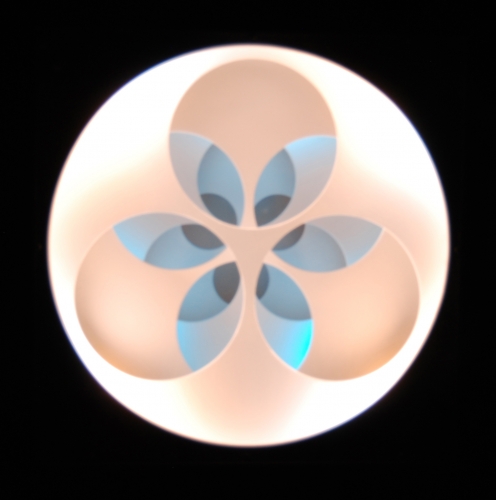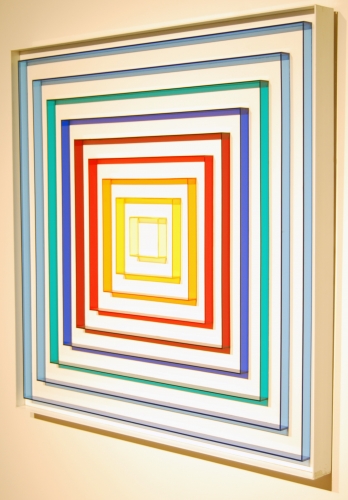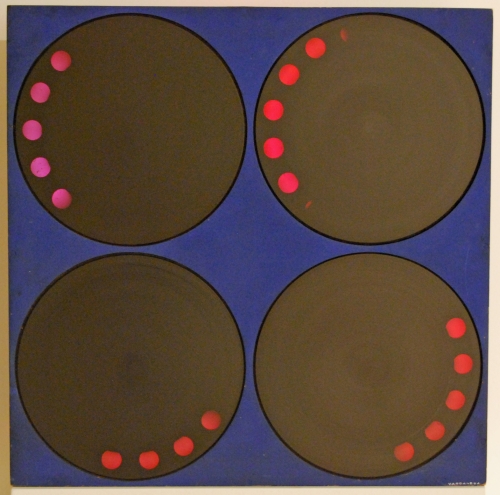Vardanega’s work can be best described as an exploration of a cosmic imaginary universe. Where aesthetics meets and plays with real time and space. Where mechanics creates a poetic language about the unknown mysteries of our world. Each work investigates the physical nature of an object, a manifestation of the external universe. Light, movement, and space create art in real time.
In 1949 Paris, Vardenega meets Vantongerloo, a former traveling companion and friend of Mondrian. It is through this meeting that Vardanega begins to conceptualize the idea of “phisicalist constructivism”. Vantongerloo “was the first to define some of the key ideas which were to dominate art in the 1960’s: the
idea of real, living energy, which is constantly in action, before our eyes, the very instant in which we see the work; the idea of indetermination, linked to the chance nature of the flow of light; the idea of invisibility, with the ‘sculpture’ no longer being a palpable organization of static substances, but an interplay of immaterial waves”. (J. Clay “From the Unchangeable to Process Art”). Vardanega, therefore, begins the deconstruction of the three-dimensional concept of reality in art.
By the mid 1960’s Vardanega and his wife, Martha Boto, were living in Paris and actively engaging with other notable Latin American expatriate artists, such as Jesus Soto and Carlos Cruz-Diez; both known for their kinetic art. Vardanega and Boto, saw themselves as technicians developing and creating works for “real science fiction scenes”. Vardanega’s growing interest in programming, cybernetics, and astronomy are clearly evident in his body of work. In 1967, Serge Gainsbourg staged a short film, starring Brigitte Bardot, titled “Contact”; which includes works from both artists. The film is a futuristic technological fantasy, very evocative of its time; a clear representation of the general public’s interest in the cosmos, artificial intelligence, and worlds beyond ours.
THE MISSION PROJECTS serves as an independent space for curators, artists, and collectors to propose exhibitions of emergent to mid career artists. The underlying theme of THE MISSION is art of the Americas, but the space is not exclusive to art from a particular region, movement, or period. The inaugural year will focus on historical exhibitions of Latin American artists and movements, opening a dialogue between emergent artists and their predecessors; thus establishing a context for future shows.
THE MISSION will serve as a catalyst for innovation and exploration of the contemporary landscape.
In 1949 Paris, Vardenega meets Vantongerloo, a former traveling companion and friend of Mondrian. It is through this meeting that Vardanega begins to conceptualize the idea of “phisicalist constructivism”. Vantongerloo “was the first to define some of the key ideas which were to dominate art in the 1960’s: the
idea of real, living energy, which is constantly in action, before our eyes, the very instant in which we see the work; the idea of indetermination, linked to the chance nature of the flow of light; the idea of invisibility, with the ‘sculpture’ no longer being a palpable organization of static substances, but an interplay of immaterial waves”. (J. Clay “From the Unchangeable to Process Art”). Vardanega, therefore, begins the deconstruction of the three-dimensional concept of reality in art.
By the mid 1960’s Vardanega and his wife, Martha Boto, were living in Paris and actively engaging with other notable Latin American expatriate artists, such as Jesus Soto and Carlos Cruz-Diez; both known for their kinetic art. Vardanega and Boto, saw themselves as technicians developing and creating works for “real science fiction scenes”. Vardanega’s growing interest in programming, cybernetics, and astronomy are clearly evident in his body of work. In 1967, Serge Gainsbourg staged a short film, starring Brigitte Bardot, titled “Contact”; which includes works from both artists. The film is a futuristic technological fantasy, very evocative of its time; a clear representation of the general public’s interest in the cosmos, artificial intelligence, and worlds beyond ours.
THE MISSION PROJECTS serves as an independent space for curators, artists, and collectors to propose exhibitions of emergent to mid career artists. The underlying theme of THE MISSION is art of the Americas, but the space is not exclusive to art from a particular region, movement, or period. The inaugural year will focus on historical exhibitions of Latin American artists and movements, opening a dialogue between emergent artists and their predecessors; thus establishing a context for future shows.
THE MISSION will serve as a catalyst for innovation and exploration of the contemporary landscape.
Gregorio Vardanega



